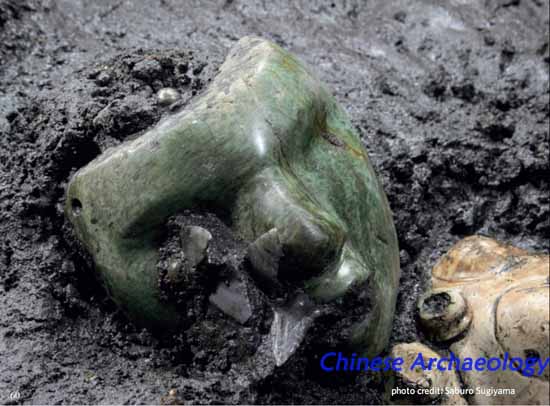Worldview and Social Histories Materialized at Monuments in Teotihuacan, Mexico
Teotihuacan lies 40 km northeast of modern Mexico City in the Central Mexican Highlands at an altitude of around 2,300 meters. This ancient city is well known for its monumental constructions, such as the Sun Pyramid, the Moon Pyramid, and the Citadel with its main temple called the “Feathered Serpent Pyramid.” These massive constructions are even more impressive, however, when one realizes that they were complementary elements of a planned city that harmoniously integrated other public buildings, numerous residential complexes, and the surrounding topography, along the main axis of the city, called “Avenue of the Dead.” Numerous public buildings and residences in the central area were excavated, consolidated, and partially reconstructed during the last century, mainly by the Mexican government, and we now know that, at its height, Teotihuacan was one of the largest Pre-Columbian urban centers in the Americas during the 2nd- 6th centuries A.D. that covered about 20 square km with its estimated population around 100,000-150,000. Although a significant number of buildings have been excavated, we have not identified dominant ethnic groups, the language spoken, the writing system, and particularly ruling entities who created and controlled this ancient planned city.

I have been involved in the explorations of the three major monuments in Teotihuacan during the last thirty years. I was exceptionally fortunate that I participated in the excavations of the Feathered Serpent Pyramid carried out by the Mexican National Institute of Anthropology and History (INAH) in 1980-82 and continuously by a joint-project of the INAH and Arizona State University in 1988-89. We uncovered more than 137 people sacrificed and buried in and around the pyramid with rich offerings. Our intensive excavations and material studies in 1990’s uncovered strong evidence of powerful rulership consolidated with military institutions around 200 AD. However, we could not specifically clarify the political organization of the ancient state, particularly evidence of rulers.

We began new explorations in 1998-2004 at the Moon Pyramid, the second largest monument at Teotihuacan. Extensive excavations around the pyramid and systematic tunnel operations within its nucleus have discovered an elaborate architectural sequence, including seven overlapping monumental constructions and five burial complexes of sacrificed individuals of high social status and abundant sacred animals associated with exceptionally rich offerings that include jaguars, pumas, wolves, eagles, and rattle snakes. As a result of the tunnel excavations we were able to confirm that enlargement programs at the Moon Pyramid often took place on a large scale and substantially changed the form and dimensions of previous monuments, and that the enlargement programs were associated with burial/offering complexes that symbolized expanding political power. The contents of the graves provided important new data regarding state religion and political organization in addition to abundant chronological materials, among others; however, we were not again able to identify individuals of the maxim authority in the Teotihuacan state.

New excavations at the Sun Pyramid, the largest pyramid in Teotihuacan, have been carried out until now by another INAH project during the last decade. We have been uncovering three major construction stages: pre-Sun Pyramid, Sun Pyramid Stage 1 (one square platform measuring roughly 215 meters per side), and Sun Pyramid Stage 2 (extension phase completely covering the earlier one). These modification processes also reflected evidently changing state politics, and the contents of the associated burial/offerings uncovered recently represent state ideology and the nature of the government more specifically. The largest pyramid also had unique features; for example, a man-made tunnel 6 meters below the pyramid was accidentally discovered. I suspect that this ancient tunnel once functioned as a royal tomb although it had been heavily rooted for centuries leaving it without solid evidence of burial contexts. Our continuing analyses of materials recovered from the tunnel and symbolic objects newly discovered at the top of the pyramid, as well as quite new explorations undergoing 15 meters below the Feathered Serpent Pyramid, are giving us critical data about their worldview and maxim ruling groups for the first time of the Teotihuacan research history.
Saburo Sugiyama (Aichi Prefectural University)
Biographical Sketch
Saburo Sugiyama, born in 1952 in Japan, is currently Professor of the Graduate School of International Cultural Studies at Aichi Prefectural University in Japan, and Research Professor of the School of Human Evolution and Social Change at Arizona State University in the USA. He obtained his Ph.D. in 1995 from Arizona State University. His major research interests include Mesoamerican Archaeology, ancient urbanism and symbolism, and theories of Cognitive Archaeology. He was engaged in numerous archaeological researches in Mexico, Guatemala, and Japan, particularly at Teotihuacan, Mexico. He carried out intensive excavations at the Moon Pyramid as co-director, also at the Feathered Serpent Pyramid and recently at the Sun Pyramid in Teotihuacan as associate director. He received in 2012 “Commendation from the Minister of Foreign Affairs, Japan” for his academic achievements for Mexican Archaeology and related international social activities. His recent publications include: 2005 Human Sacrifice, Militarism, and Rulership: Materialization of State Ideology at the Feathered Serpent Pyramid, Teotihuacan. Cambridge University Press: 2007 “The Moon Pyramid Project and the Teotihuacan State Polity” in Ancient Mesoamerica, 18: 2010 “Teotihuacan City Layout as a Cosmogram” in The Archaeology of Measurement: Comprehending Heaven, Earth and Time in Ancient Societies, Cambridge University Press. 2010年。

